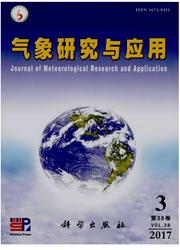

 中文摘要:
中文摘要:
利用1°×1°的NECP/NCAR再分析资料、逐3h的TRMM卫星反演降水资料和FY-2E卫星TBB资料以及美国大气和海洋局(NOAA)的HYSPLITv4.8气流三维轨迹扩散模式,诊断分析了2010年5月6~7日广州地区的大暴雨降水过程。结果表明:该大暴雨过程发生在500hPa高空脊前,低空切变线,低涡和锋面是其主要影响系统;生成于广西东北部的MCC东移发展南压到广州地区停滞,直接导致了广州的暴雨发生;在这次暴雨过程中,高层的辐散远大于低层的辐合,高层对低层的抽吸作用可能是该次锋前暖区暴雨的一个触发机制;南海是低层水汽的主要来源地,高层气流从偏西路径影响广州,水汽辐合大值区先于暴雨发生前出现,在暴雨结束前率先有水汽的辐散,水汽的辐合与辐散对预报暴雨有一定的指示意义。
 英文摘要:
英文摘要:
By using NCEP 6-hourly reanalysis data、3-hourly TRMM data、the hourly satellite TBB data、HYSPLIT v4.8 Model,the rainstorm event over Guangzhou during 6-7 May 2010 is analyzed.Results show that:rainstorm is appearing ahead of 500hPa ridge.Surface shear、lower-vortex,front are favorable to the development of the rain-storm system.The stagnation of MCC in Guangzhou which generated in the northeast of Guangxi is the direct reason for severe heavy rainfall.The pumping action of upper-level divergence may be a trigger mechanism of this heavy rain.South China Sea is the main source of low-level water vapor.High-level airflow affects Guangzhou from west.Convergence and divergence of water vapor have an indicative meaning for development of rainstorm.
 同期刊论文项目
同期刊论文项目
 同项目期刊论文
同项目期刊论文
 Microphysical and radiative effects of ice clouds on responses of rainfall to the large-scale forcin
Microphysical and radiative effects of ice clouds on responses of rainfall to the large-scale forcin Sensitivity of cloud-resolving precipitation simulations to uncertainty of vertical structures of in
Sensitivity of cloud-resolving precipitation simulations to uncertainty of vertical structures of in Roles of large-scale forcing, thermodynamics, and cloud microphysics in tropical precipitation proce
Roles of large-scale forcing, thermodynamics, and cloud microphysics in tropical precipitation proce 期刊信息
期刊信息
